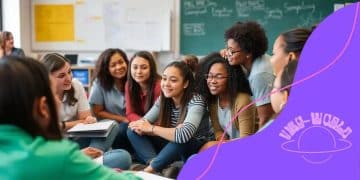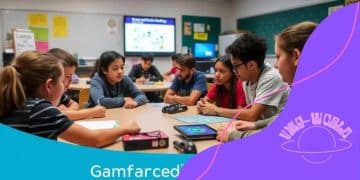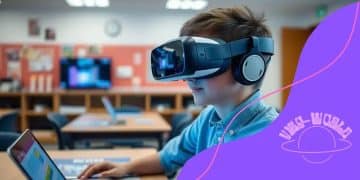Remote learning technology innovations transforming education
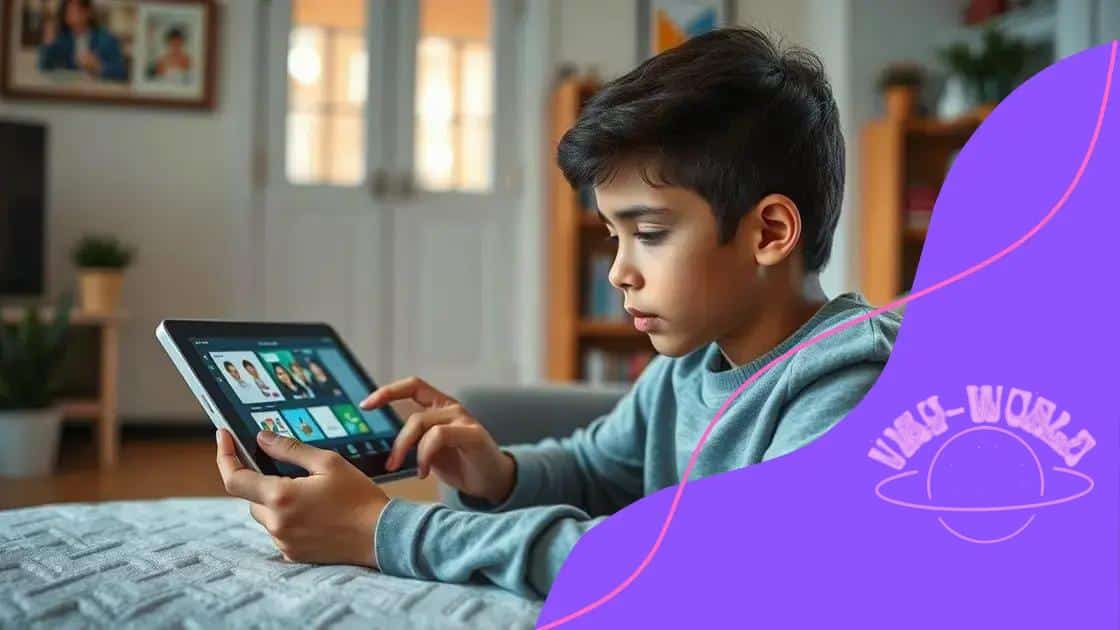
Remote learning technology innovations significantly enhance education by providing personalized learning experiences, flexible access to resources, and immersive environments through tools like AI, VR, and microlearning.
Remote learning technology innovations have changed the educational landscape, making learning more accessible and engaging than ever. Have you considered how these tools can enhance your learning experience? Let’s dive in!
Exploring the latest remote learning technologies
In today’s education scene, remote learning technologies play a vital role. They connect students and teachers, fostering interaction and engagement.
Key Technologies in Remote Learning
Several innovative tools have emerged to enhance the remote learning experience:
- Video Conferencing Platforms: Tools like Zoom and Google Meet enable live classes.
- Learning Management Systems (LMS): Systems such as Moodle or Blackboard organize courses efficiently.
- Interactive Tools: Applications like Kahoot! make learning fun through quizzes and games.
These technologies streamline communication and improve collaboration among students. For instance, video conferencing allows real-time interaction, which is crucial for keeping learners engaged.
Benefits of Remote Learning Technologies
Adopting these remote learning technologies offers numerous benefits, including:
- Greater accessibility to educational resources.
- Flexible learning schedules that cater to individual needs.
- Opportunities for personalized learning experiences.
As schools and colleges increasingly shift to online platforms, students have access to a broader range of courses. This flexibility assists in meeting different learning styles and preferences.
Moreover, remote learning fosters global collaboration. Students can participate in projects with peers from different regions, which enhances their understanding of diverse perspectives. These connections encourage teamwork and critical thinking skills.
Additionally, educators can utilize various resources to create engaging content. For example, they can use multimedia elements to enrich their lessons, making them more appealing to students. This includes videos, podcasts, and interactive simulations that captivate learners’ attention.
In summary, exploring the latest remote learning technologies reveals how they revolutionize education. By embracing these tools, educators and students can thrive in an ever-evolving educational landscape.
Benefits of innovative remote learning solutions
Innovative remote learning solutions offer numerous advantages for both students and educators. By utilizing these technologies, learning becomes more engaging and accessible.
Increased Flexibility
One of the main benefits is the flexibility they provide. Students can study at their own pace and choose when to participate in lessons. This approach caters to individual learning styles, making education more personalized.
- Students can access resources anytime, anywhere.
- Learning can be tailored to fit a student’s schedule.
- Students are empowered to take control of their education.
This flexibility is particularly beneficial for those balancing school with work or family commitments, allowing them to navigate their responsibilities more easily.
Enhanced Engagement
Another significant advantage is enhanced engagement. Innovative tools such as interactive quizzes or virtual reality environments make learning dynamic. These technologies transform traditional lessons into interactive experiences. Gamification keeps students motivated through rewards and challenges, capturing their interest.
By incorporating multimedia elements, educators create richer educational experiences. For example, videos and simulations can illustrate complex concepts more clearly than textbooks alone. This variety caters to different learning preferences, helping all students succeed.
Furthermore, remote learning solutions foster collaboration among students. They can work together on projects using online platforms, enhancing teamwork skills. This connection not only aids learning but also simulates real-world work environments.
Furthermore, educators benefit significantly as well. They can utilize data analytics to tailor instruction and improve student outcomes. This insight helps them identify which areas students struggle with and adapt their teaching strategies accordingly.
In summary, the benefits of innovative remote learning solutions shape the future of education. By embracing these advancements, students and teachers alike can thrive in a more connected, flexible, and engaging learning environment.
Real-life applications of remote learning tools
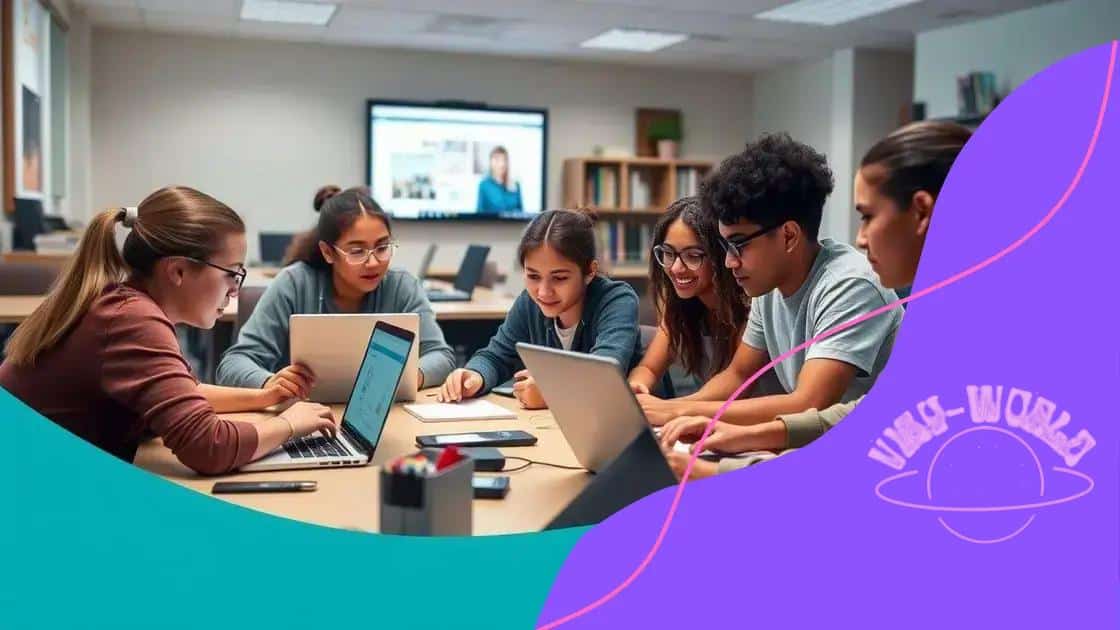
Real-life applications of remote learning tools showcase their versatility in various educational settings. These tools are not just theoretical but are actively used to enhance learning outcomes.
Virtual Classrooms
Many schools have adopted virtual classrooms to facilitate real-time learning. Platforms like Google Classroom and Microsoft Teams allow teachers to conduct live lessons. This setup replicates a traditional classroom environment.
- Teachers can share lessons and resources instantly.
- Students can participate in discussions just like they would in class.
- Assignments can be submitted and graded online, streamlining the process.
This transition ensures that learning continues seamlessly, even when students cannot physically attend school.
Online Collaborative Projects
Remote learning tools also support collaborative projects among students. Using tools like Padlet or Miro, students can work together on assignments from their homes. They can share ideas, create presentations, and even solve problems collaboratively.
These platforms encourage teamwork and communication skills while allowing students to engage with their peers. This cooperation fosters a sense of community, even in a virtual environment.
Another practical use is online tutoring. Students can access help from educators or peers on platforms like Khan Academy or Tutor.com. This way, they receive personalized support tailored to their learning needs.
Furthermore, educators can benefit from professional development through remote learning tools. Workshops and training sessions are readily available online, helping teachers incorporate new technologies into their classrooms.
By seeing real-life applications of remote learning tools, we understand their impact on education today. These tools create an adaptable learning environment, making education more accessible and interactive for everyone involved.
Challenges in implementing remote learning technology
Challenges in implementing remote learning technology can impact both students and educators. While these technologies offer numerous benefits, they also come with obstacles that must be addressed.
Technical Issues
One significant challenge involves technical issues. Not all students and schools have access to reliable internet or the necessary devices. This digital divide creates inequalities in learning opportunities.
- Poor internet connection can disrupt live classes.
- Students may struggle without a personal computer or tablet.
- Technical glitches can hinder the learning experience.
In many cases, schools need help finding solutions to provide equitable access to technology.
Adaptation for Educators
Another challenge is the need for educators to adapt to new technologies. Teachers may not be familiar with all the tools available for remote learning. This can lead to frustration and ineffective teaching methods.
Training programs are essential. Educators should have access to professional development to learn how to integrate technology effectively. Moreover, the time spent learning new systems can take away from lesson preparation.
Additionally, some educators may be resistant to change, preferring traditional teaching methods. Overcoming this resistance is crucial for a successful transition to remote learning.
Student Engagement
Keeping students engaged in a remote environment can also be challenging. In a physical classroom, teachers can use body language and facial expressions to gauge interest. However, in virtual settings, this is more difficult.
Strategies to promote engagement include:
- Incorporating interactive elements into lessons.
- Encouraging participation through discussions and chat functions.
- Using gamification to motivate students to engage with content.
Remote learning requires different techniques to ensure students remain focused and motivated. Teachers need to be creative in finding ways to connect with their students.
Ultimately, addressing the challenges in implementing remote learning technology is essential for creating an inclusive and effective learning environment. By identifying and tackling these issues, educators can enhance the overall educational experience.
Future trends in remote learning technology
Future trends in remote learning technology are shaping the way education is delivered. As technology evolves, so do the methods and tools used in remote learning environments.
Increased Use of Artificial Intelligence
One major trend is the increased use of artificial intelligence (AI) in education. AI can provide personalized learning experiences for students. For example, AI-based platforms can adapt to a student’s pace, offering customized resources and feedback.
- AI tutors can assist students in understanding complex topics.
- Data analytics can identify areas where students struggle, allowing for targeted interventions.
- Automated grading systems can streamline assessments, saving teachers time.
This tailored approach helps students learn more effectively, making education accessible to diverse learners.
Virtual Reality and Augmented Reality
Another exciting trend is the use of virtual reality (VR) and augmented reality (AR) in remote learning. These technologies create immersive learning environments where students can explore concepts in depth.
For instance, VR can transport students to historical sites or scientific laboratories, enhancing their understanding through visualization and interaction. Similarly, AR can overlay digital information onto the real world, providing context to physical objects.
This hands-on experience can improve retention and engagement significantly, making learning memorable.
Microlearning and Bite-sized Content
Additionally, microlearning is gaining popularity as a trend in remote education. This approach involves breaking down lessons into smaller, more manageable segments.
Microcontent allows students to learn at their own pace without feeling overwhelmed. It fits well with busy schedules and caters to short attention spans. Key points of lessons can be delivered through videos, podcasts, or quizzes, allowing students to absorb information quickly.
As we look towards the future, the trends in remote learning technology are not just about tools but also about enhancing the overall learning experience. With the integration of AI, immersive technologies like VR and AR, and microlearning strategies, education is becoming more engaging, personalized, and effective.
Conclusion: As we move forward, it’s clear that remote learning technology is transforming education in remarkable ways. With continued advancements, we can expect more personalized learning experiences that truly engage students. The integration of tools like AI, VR, and microlearning will enhance how individuals learn and teach. It opens up a world of possibilities, making education more accessible and exciting for everyone. Embracing these changes can lead to better knowledge retention and growth for students everywhere.
FAQ – Frequently Asked Questions about Remote Learning Technology
What are the main benefits of remote learning technology?
Remote learning technology offers flexibility, accessibility, and personalized learning experiences that cater to individual student needs.
How can AI improve remote learning experiences?
AI can provide tailored content, adaptive learning paths, and instant feedback to help students engage better with the material.
What role do virtual reality and augmented reality play in education?
VR and AR create immersive learning environments that enhance understanding and retention by allowing students to experience concepts firsthand.
What challenges do schools face when implementing remote learning?
Schools encounter issues like technical access, teacher training, and maintaining student engagement, which can hinder successful adoption.


